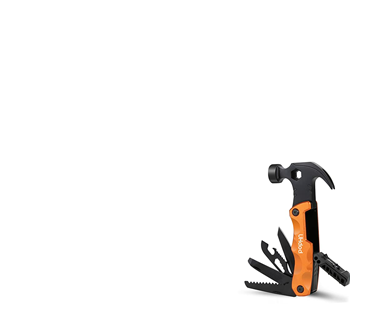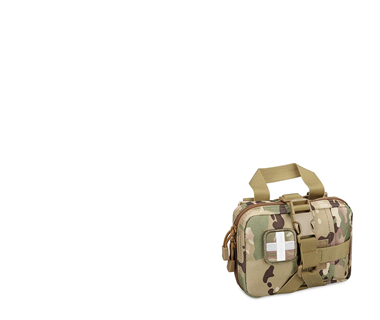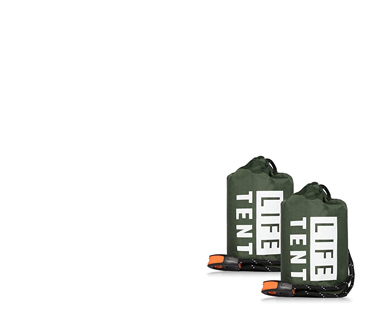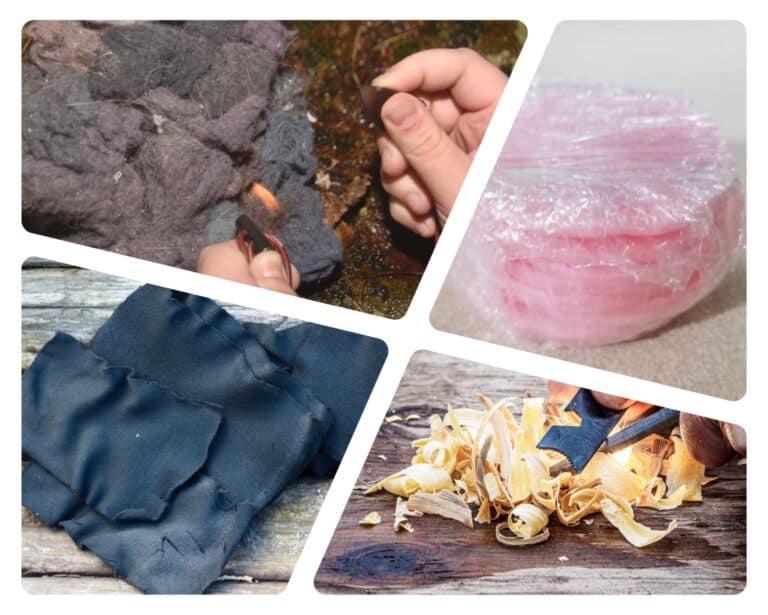21 DIY Fire Starters That Light Up Instantly Leave a comment
Every outdoorsman, Boy Scout, and prepper learns early on about the importance of fire when you’re out in the wilderness.
Exposure to the elements is the single biggest issue when folks wind up in an outdoor survival situation, and a warm summer day can turn downright frigid at night if you are exposed to a stiff wind or, worse, get wet.
Being able to start a fire quickly using whatever fuel is available is important, but even if you’ve got a lighter, matches, or a flint and steel, starting that fire can be downright difficult without good tinder.
Tinder, or firestarter, is the initial fuel you’ll use to catch a spark and then ignite the larger stuff to make a long-lasting, warm, and radiant campfire…
You can find materials that will work as fire starters in the wilderness, but a better bet is to make your own and keep it with you as part of a survival kit. I’ll tell you how to make 20 great DIY fire starters in this article.
pinewood and cones ready to be set on fire
Dried Pinecones
One of the best and most ubiquitous DIY fire starters is a simple dried pine cone. Yep! Nothing more to it than that.
Pinecones contain volatile oils and resins that will catch fire readily, burn hot, and burn for several minutes, and that open, flanged structure of the cone itself means it will burn evenly long enough for you to get it in position and then start the fire properly.
The only trick is that the cones need to be fully dry, meaning you won’t always be able to come up with a suitable one in the wild at a moment’s notice. But on the other hand, pine cones are bulky and fragile, not something you necessarily want to carry with you.
My solution? I keep a few in the car and I keep small or miniature pine cones in my pack as part of my fire-starting kit. I’ve been using them for years and they work wonders. They smell wonderful, too!
a feather stick
Feather Sticks
Feather sticks are an old woodsman’s trick for starting a fire easily using nothing more than a twig, a knife, and a little bit of know-how. Basically, all you want to do is make a succession of fine cuts, lengthwise, into the twig or stick but without cutting the shavings off.
The result should look kind of like a little pine tree itself. This will also work a lot better if it is a dead and dry twig or stick, but it’s possible to make a green one work if you’re really in a pinch.
Once you’ve made these cuts around the entirety of the surface and from one end to the other, it should catch fire instantly and burn quite hot.
It won’t take long to burn up, so work fast and make sure you have your kindling prepared and ready to accept it. A great method because it can be improvised anywhere with just a couple of minutes’ effort.
setting dryer lint on fire with ferro rod
Dryer Lint Balls
This is an old hunters’ and hikers’ trick that has been around a while, but that’s for good reason: it works and works like a charm!
Simply collect dryer lint from your dryer, either the exhaust tube or the lint trap, and then store it in a waterproof container.
Really pack it in there dense so you can carry a ton of it. When you need to start your fire, pull out a wad and then gently pull it apart until it is a light, fluffy mass with a somewhat denser core.
Even a single spark will likely cause it to light up, then you can use the bundle to ignite the rest of your fuel. Totally free and highly effective, I love it…
The only downside? If it gets wet, or even damp, it will be totally hopeless so make sure you invest in a good waterproof container for it. I keep mine inside a Ziploc bag and put that inside a small storm case.
Duct-Tape “Torch”
One of my favorite hastily improvised fire-starting methods is the duct tape torch. Duct tape isn’t particularly flammable, but it burns steadily and is easy to ignite with a lighter or matches.
Grab any convenient stick, but preferably a dry one that itself will light up, and then tear a piece of duct tape into thin strips. Place these strips vertically with the ends just hanging off the end of the stick, pressing them together into a shape that looks a little bit like a crown.
Light up the strips where they join together, and they should burn and smolder for quite a while. This is a great way to get more control over the ignition process if you’re working with stubborn kindling as it allows you to keep control of the stick and hold the flame right where you need it.
Wax and Gauze Firestarters
Wax, from old candles or even something like crayons, can be a great resource when creating fire starters.
Not only does it serve as a fuel source itself, but when solidified, it can waterproof the material that you have applied it to, meaning your fire-starting kit is better ready to face the elements.
This simple fire starter variety is nothing more than gauze pads or patches dipped in a pot of melted wax. Give them a quick dip with tongs, let the excess run off, and then set them aside on a nonstick surface to harden.
They’re easy to store and carry, and when you’re ready to light up all you need to do is snap them in the middle to expose fresh, dry gauze, fluff it up a little bit, and then ignite.
Hand Sanitizer-Soaked Cloth
Hand sanitizer is surprisingly, even ferociously, flammable. Especially the strong stuff that has higher alcohol content. The gel-like nature also makes it more controllable and less likely to flash off, giving you an intense, hot, and reasonably long-lasting burn time.
Take spare patches of natural cloth, be it cotton, burlap, or something else, and then completely soak it in hand sanitizer before sealing it up in a plastic bag or another airtight container. That’s necessary because otherwise, the hand sanitizer will evaporate entirely over time.
When you need to get your fire going, place one or two patches near your kindling and then carefully ignite. Take care because it will burn quite hot and almost instantly!
Vaseline-Soaked Cotton Balls
A similar methodology to the previous entry on our list, this is another old-timer’s trick that has stood the test of time for a reason. Vaseline is also fairly flammable and compared to hand sanitizer, it’s longer-lasting.
Take a pot and smash cotton balls into it, rolling them around until they are completely saturated. Store them in an airtight container or plastic baggie to keep them from turning dry and crumbly.
To use, pull out a ball or two, pull one end apart into a frizzy mass, and then light that part. It will burn quick and hot but settle down as it reaches the more compacted part of the ball. These cost almost nothing to make and are extremely easy to carry. Another one of my favorites.
Rubber Inner Tube Strips
Yet another classic method and one that is as viable today as it has been for decades. Thin strips of rubber are pretty easy to ignite and they will burn steadily, controllably, and quite hot for several minutes.
The very best material for this purpose is a bicycle inner tube. You can usually get old, ruined tires for free from bicycle shops.
Simply remove the inner tube, cut it so that it is a long snake shape, and then cut it into smaller strips that are one to two inches long. A steady flame from a match or lighter is typically needed to ignite them.
I love this technique because it’s thrifty, and also because these thin strips are painless to carry in any number of ways.
Paraffin Fire Discs
Paraffin Fire Discs
One of the best all-around DIY fire starters you can possibly make are these paraffin fire discs.
Combining paraffin wax and paraffin lamp oil as an accelerant, and using round cotton cosmetic pads to hold it together, these are cheap, very easy to ignite and they burn hot, bright, and long.
They’re also thin and easy to carry, meaning you can always have enough with you for the job.
The only downside is that making them is fairly involved compared to the other projects on our list, but it is well worth it if you want to be truly prepared.
Filling these muffin cups with sawdust to make some fire starters…
Sawdust Fire Starters
Another tried and true classic, using sawdust, thin wood shavings, paraffin wax, or some other kind of candle wax, you can combine the ingredients in muffin cups to make little fire-starting pucks that are convenient to carry and can get a large fire going all on their own.
This is another DIY method that works wonderfully, but requires some dedicated prep on your part. It’s not something you can whip together at the moment!
But spending half an hour at the stovetop or at your workbench can give you a sizable supply that will keep you well-equipped all year long. I won’t go into all the details here, but I did include this step-by-step walkthrough.
Corn Chips
It sounds hilarious, but greasy corn chips make wonderful tinder! Being nothing but carbohydrates, they are a ready-made fuel, and the oil they contain is quite the accelerant.
A small pile of these will light up instantly from the application of an open flame, and with some diligent striking on a flint or ferro rod, you can do the same if you crush one up into a fine powder.
This is a wonderful improvised option if you have nothing else at hand, and you can make a case for keeping a lunchbox-sized bag of Fritos in your pack for just such an occasion. The only shortcoming? I’m always tempted to eat them when I’m hungry!
Burlap “Cigars”
A truly clever method that gives you great control over lighting larger pieces of fuel, or one that you can use to get stubborn or substandard fuel going.
Cutting out small rectangles of burlap, about 4×6 in area, you can slather one of the short ends with Vaseline before then rolling it up into a tube shape. Hence why they are called cigars!
Then you simply light one end and let it burn continuously. I have found that they usually produce quite a large flame for their small size, and that makes them uniquely useful.
And because of the way they burn, it will take several minutes for them to burn from one end to the other. Great if you need to buy a little time.
Jute Bundles
Your great-grandpa used it, your grandpa used it, and your dad probably used it. Jute fiber is coarse, frizzy, and burns readily when dry, meaning it’s easy to turn into a little tumbleweed shape before lighting up.
The fiber also has additional utility purposes, meaning it is a great addition to any bug-out bag or survival kit.
Tea Bags
Tea bags, yes just garden-variety tea bags filled with tea, are surprisingly capable and cheap fire starters. It makes perfect sense when you think about it: these are super-fine fabric bags containing extremely dry plant material!
I’m not saying that I would necessarily choose tea bags over other DIY options on this list, if you habitually carry tea with you, like I do, it can be a good quick-and-dirty option if you’re out of your usual stuff or have lost it.
Self-Igniting Fire Starter
Another nifty tinder that you can assemble yourself is this so-called self-igniting variety. All you’ll do is wrap a decent length of toilet paper around a strike-anywhere match, leaving the head unwrapped. Dunk the bundle into melted paraffin wax and then leave it to dry completely.
To use, gently scrape away the wax covering the head of the match, then strike and place the bundle on your kindling. It will burn up nicely!
Egg Carton Firestarters
This is a prepper trick that has been around since survival advice started to proliferate on the internet.
Find yourself a classic cardboard or fiberboard egg carton, stuff each of the little slots with wood shavings, dryer lint, gauze pads, or some other kind of fluffy material, then cover each one with melted candle wax, making sure that each fiber bundle is totally saturated.
Once everything has cooled and is completely solid, cut out the individual little cells, leaving the cardboard part of the carton attached as an additional fuel source.
You can light the carton itself directly, or scrape away a bit of wax to expose the fiber. They burn for a long time and are dirt cheap to make. Another winner!
using the whole length of uberleben zunden ferro rod in fatwood shavings
Wood Shavings
Sometimes simple is best. Fine wood shavings will burn immediately and hot as long as they are completely dry.
If you gathered a decent quantity of dry kindling, choose a branch or twig that is very dry and brittle before shaving it down as fine as you can with your knife.
Take care that your pile of shavings doesn’t blow away! Hit it with a shower of sparks from a flint and steel or a lighter, and it should light up at once.
This is another fundamental fire-starting technique that every prepper should know…
DIY char cloth from pieces of denim
Char Cloth
One of the oldest and still one of the best fire starters around, char cloth is made from exposing cloth, usually cotton, to extremely high temperatures in an oxygen-free environment, usually a sealed metal tin.
It takes a little while, but the end result is a product that looks a lot like flaky charcoal and will ignite with zero provocation. It has been a fixture in tinder boxes for hundreds of years and for good reason!
This is another DIY fire starter that requires an investment of effort and time from you to make, but it’s one of the very best and will give you old-school credit with the seasoned survivors in your group.
box filled with newspaper
Crumpled Newspaper/Magazine Paper
If you have any quantity of dry newspaper or magazines, that’s all you need to get a fire going quickly.
Used in everyday life as an ignition source for chimney starters when firing up a charcoal grill, you can tear out sheets, crumple them up repeatedly until they soften, and then twist them into strands, tear them up into small pieces, or use them in other ways to get your fire going.
Not necessarily my first choice, but definitely a viable one and a resource to be on the lookout for if you’re ever in a survival situation.
tallow wrapped in cotton fire starters
Tallow Balls
These are as straightforward as they sound. Clump the tallow into balls, then wrap them into pieces made of cotton. Set fire as usual.
Dried Orange Peel
The last entry on our list of DIY fire starters is one that’s bound to surprise some readers.
It’s hard to imagine any juicy piece of fruit actually catching fire, but in the case of orange peels, and the peels of other citrus fruits, if you let them dry all the way out, they will prove to be shockingly flammable.
That’s because of the volatile oils they contain, and devoid of moisture the fibrous material of the peel itself serves as a ready fuel source.
If you aren’t throwing your peels into the garbage or onto the compost pile, consider keeping them for just this purpose assuming your partner doesn’t run off with them to make potpourri or simmer pot mixes!
The post 21 DIY Fire Starters That Light Up Instantly appeared first on Survival Sullivan.




